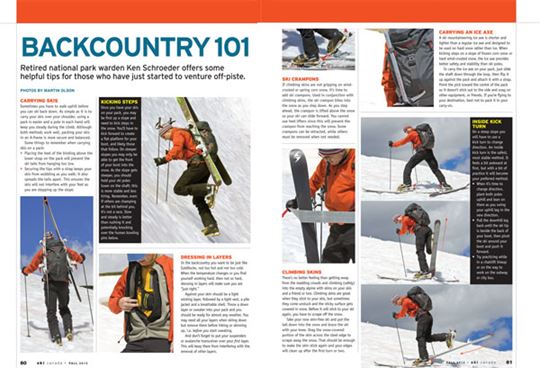Retired national park warden Ken Schroeder offers some helpful tips for those who have just started to venture off-piste.
PHOTOS BY MARTIN OLSON in Fall 2013 issue
Carrying skis
Sometimes you have to walk uphill before you can ski back down. As simple as it is to carry your skis over your shoulder, using a pack is easier and a pole in each hand will keep you steady during the climb. Although both methods work well, packing your skis in an A-frame is more secure and balanced.
Some things to remember when carrying skis on a pack:
• Placing the heel of the binding above the lower strap on the pack will prevent the ski tails from hanging too low.
• Securing the tips with a strap keeps your skis from wobbling as you walk; it also spreads the tails apart. This ensures the skis will not interfere with your feet as you are stepping up the slope.
Kicking steps
Once you have your skis on your pack, you may be first up a slope and need to kick steps in the snow. You’ll have to kick forward to create a flat platform for your boot, and likely those that follow. On steeper slopes you may only be able to get the front of your boot into the snow. As the slope gets steeper, you should hold your ski poles lower on the shaft; this is more stable and less tiring. Remember, even if others are champing at the bit behind you, it’s not a race. Slow and steady is better than rushing it and potentially knocking over the human bowling pins below.

Dressing in layers
In the backcountry you want to be just like Goldilocks, not too hot and not too cold. When the temperature changes or you find yourself working hard, then not so hard, dressing in layers will make sure you are “just right.”
Against your skin should be a light wicking layer, followed by a light vest, a pile jacket and a breathable shell. Throw a down layer or sweater into your pack and you should be ready for almost any weather. You may need all your layers when skiing down but remove them before hiking or skinning up, i.e. before you start sweating.
And don’t forget to put your suspenders or avalanche transceiver over your first layer. This will keep them from interfering with the removal of other layers.
Carrying an ice axe
A ski mountaineering ice axe is shorter and lighter than a regular ice axe and designed to be used on hard snow rather than ice. When kicking steps on a slope of frozen corn snow or hard wind-crusted snow, the ice axe provides better safety and stability than ski poles.
To carry the ice axe on your pack, just slide the shaft down through the loop, then flip it up against the pack and attach it with a strap. Point the pick toward the centre of the pack so it doesn’t stick out to the side and snag on other equipment, or friends. If you’re flying to your destination, best not to pack it in your carry-on.
Ski crampons
If climbing skins are not gripping on wind-crusted or spring corn snow, it’s time to add ski crampons. Used in conjunction with climbing skins, the ski crampon bites into the snow as you step down. As you step ahead, the crampon is lifted above the snow so your ski can slide forward. You cannot use heel lifters since this will prevent the crampon from reaching the snow. Some crampons can be retracted, while others must be removed when not needed.
Inside kick turn
On a steep slope you will have to use a kick turn to change direction. An inside kick turn is the safest, most stable method. It feels a bit awkward at first, but with a bit of practice it will become your preferred method.
• When it’s time to change direction, plant both poles uphill and lean on them as you swing your uphill leg in the new direction.
• Pull the downhill leg back until the ski tip is beside the back of your boot, then pivot the ski around your boot and push it forward.
• Try practicing while in a chairlift lineup or on the way to work on the subway or city bus.
Climbing skins
There’s no better feeling than getting away from the madding crowds and climbing (safely) into the empty alpine with skins on your skis and a friend or two. Climbing skins are great when they stick to your skis, but sometimes they come unstuck and the sticky surface gets covered in snow. Before it will stick to your ski again, you have to scrape off the snow.
Take your now skin-free ski and put the tail down into the snow and brace the ski with your knee. Drag the snow-covered portion of the skin across the steel edge to scrape away the snow. That should be enough to make the skin stick again and your edges will clean up after the first turn or two.



